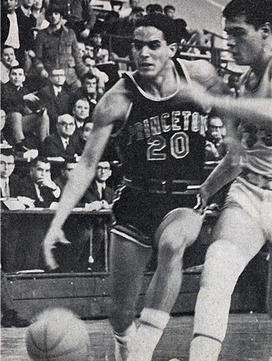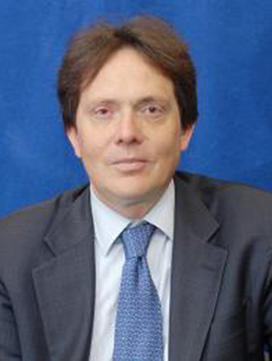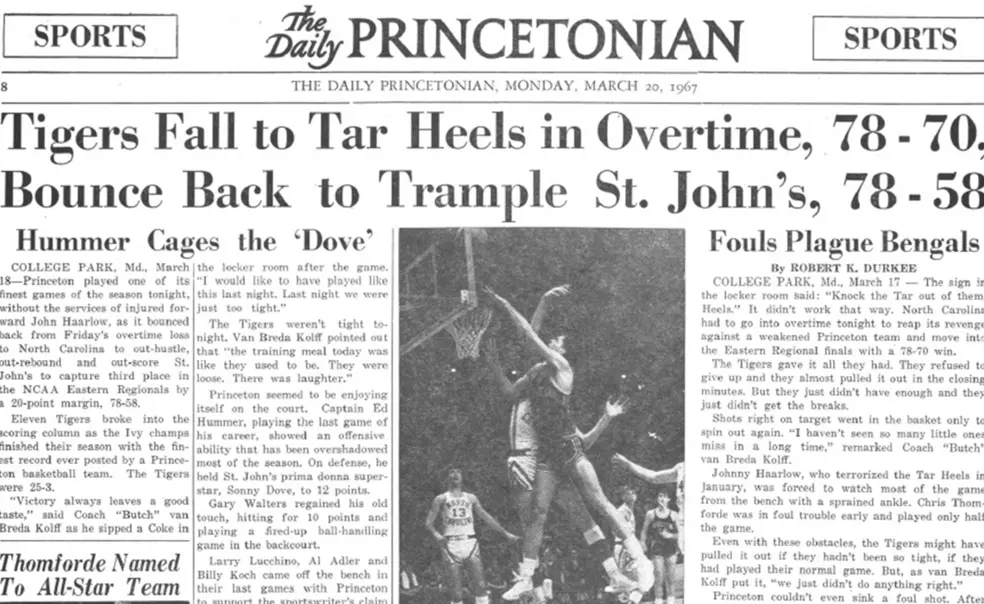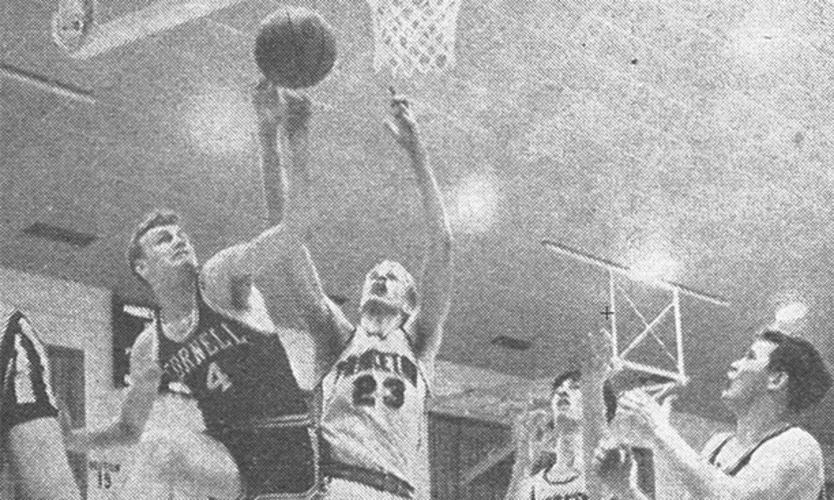As the Princeton men’s basketball team set a new Ivy League best with its 16-0 record in league games this year, the program also marked the golden anniversary of perhaps its greatest team, the 1966-67 Tigers.
Overshadowed by Bill Bradley’s 1964-65 team that made a storied run to the Final Four, the Princeton team that followed two years later had the University’s most successful regular season, setting numerous school records: fewest losses (two, a mark that stood for more than 30 years); most points scored in a game (116, without the benefit of the 3-point shot), and highest AP ranking (No. 3).
Princeton handed Dean Smith’s North Carolina team a rare home loss in Chapel Hill and beat Villanova twice, losing only to Louisville and its future NBA Hall-of-Famer Wes Unseld and to Cornell on the road.
At the peak of the team’s success in February 1967, star point guard Gary Walters ’67 — a holdover from the Bradley years — and standout sophomore center Chris Thomforde appeared on the cover of Sports Illustrated under the title: “Princeton Builds a Basketball Dynasty.”
Walters, who became Princeton’s athletic director following a successful career in finance, remembers “a unique team where all the parts blended well together. It was extraordinary in how the team was greater than the sum of its parts.”
Walters was the team’s spark. The son of a steel welder from Reading, Pa., his high school coach was Pete Carril, who had been a scrappy point guard for Princeton coach Butch Van Breda Kolff during the latter’s stint at Lafayette.

Fellow coach Bobby Knight called Van Breda Kolff one of the greatest offensive minds in basketball. His motion offense, as captain Ed Hummer ’67 described it, relied on movement without the ball and five players who could pass and react to the first step of their teammates — a freelance offense with little one-on-one play. “When we were playing well,” Hummer said, “There were very good teams that could not play us man-to-man.”
Those accustomed to Princeton’s more deliberate style would have found this fast-paced offense surprising. Indeed, Dartmouth coach Dave Gavitt — the victim of Princeton’s 116-point onslaught and future founder of the Big East conference, responded in the rematch by taking stalling to an extreme. In the era before the shot clock, Dartmouth passed up open shots and held the ball as long as eight minutes at a time, eventually succumbing 30-16.
Thomforde, whom Walters called “as fine a passing center as ever played the game,” was an ideal fit for this offense. Telling Sports Illustrated that he anticipated becoming a minister, Thomforde later became president of three colleges: Bethany in Lindsborg, Kans., St. Olaf in Northfield, Minn., and Moravian College in Bethlehem, Pa.
Van Breda Kolff’s strong personality, booming voice, and disdain for authority helped to create a close-knit team. Backup guard Steve Pajcic ’68 said, “He didn’t have to resort to having any artificial rules to engender respect from the players.”
In mid-winter, following a deflating loss to Cornell, Van Breda Kolff burst into a roadside diner and commandeered a waiter’s uniform and towel, emerging from the kitchen to serve the players. The tension broken, the team started a new winning streak.
While the packed gyms that Bradley drew remained, it was something of a theatre crowd, Thomforde remembers: “People used to wander in and out. They would clap, not cheer. The basketball team was a bit like a department, appreciated rather than adored. VBK used to resent it sometimes.” But in the home rematch against Cornell that decided the Ivy League championship, fans both showed up and cheered wildly.If the 1965 run to Final Four reflected “a whole team touched with stardust,” as Sports Illustrated writer Frank Deford ’62 put it, the 1967 postseason was star-crossed. One of the favorites to come out of the Eastern bracket, Princeton won its opener against West Virginia. But the Tigers lost an overtime rematch to North Carolina, 78-70. Walters was hampered by a torn groin muscle he suffered late in the season, restricting his mobility, and forward John Haarlow ’67 suffered an ankle sprain that sidelined him for all but four minutes against the Tarheels.
Hummer said at the team’s senior farewell banquet that “though we had achieved some success, we wanted much more.” Years later, Hummer would recall the sting of defeat but acknowledge the feeling of inclusion in a special club, echoing A Chorus Line: “When I see really good college basketball or watch a team go to the Final Four, I feel I share that experience. The gift was ours to borrow.”
Players from the team went on to remarkable worldly acclaim. As president and CEO of the Boston Red Sox, Larry Lucchino ’67 was an architect of the team’s first World Series champion in 86 years. Alan Adler ’67 produced films in Hollywood. Pajcic ran for governor of Florida. David Lawyer ’68, the team’s sixth man, track star, and only African-American player, became a distinguished political scientist. And Tom Chestnut, a sparingly-used reserve, was captured bare-chested at Woodstock in an iconic photo of the 1960s. Following a stint in marketing he went on to become president and chief operating officer of the NBA’s Cleveland Cavaliers.
The colorful Van Breda Kolff left Princeton after that season to coach the Los Angeles Lakers and endured a turbulent few years as the foil to Jerry West and Wilt Chamberlain. His protégé Carril, who succeeded him, forged the indelible modern image of Princeton as a group of overachieving Davids. The 1966-67 Princeton team, however, was the last to audition for the role of Goliath.














3 Responses
Robert E. “Bob” Buntrock *67
8 Years AgoThanks for the memories
Thanks for the memories.
Lawrence Cheetham ’67
8 Years AgoBrilliant look back....
Brilliant look back. Absolutely brilliant. Oh, those memories!
VBK gave us such a ride, starting with WWB's surprise walk-on, at frosh basketball. Walters was immense. They all were. The antithesis of 1-on-1 ball. As akin to selflessness as "Princeton In the Nation's Service" purports.
Paul Hauge ’80
8 Years AgoAmazing that this...
Amazing that this post-Bradley, pre-Carril juggernaut could get overlooked. Thanks for reminding this long-time Tigers fan about a great team.